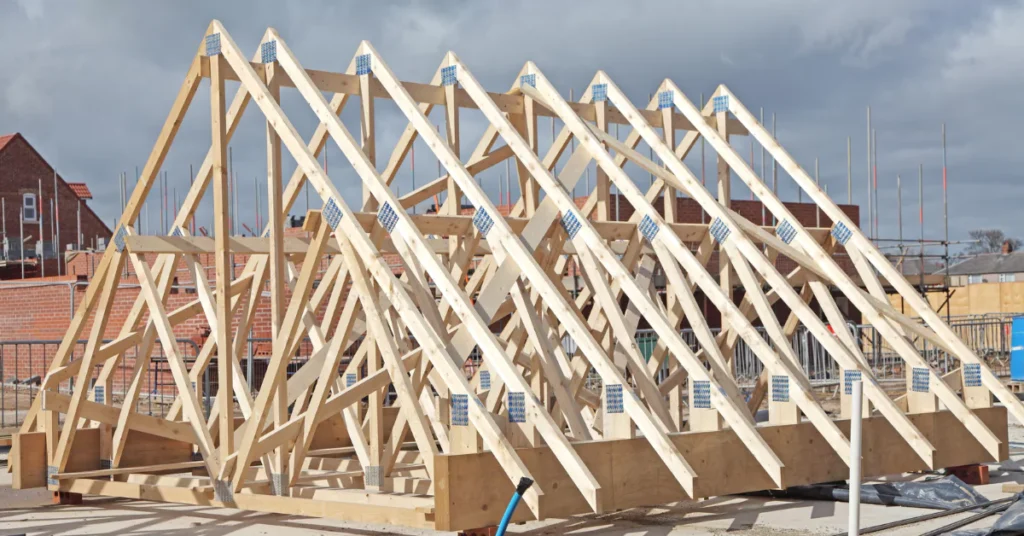When it comes to constructing a building, whether it’s a home, shed, or any other structure, roof framing plays an essential role. Not only does it provide structural integrity, but it also helps protect the building from external elements such as rain, wind, and snow. If you’re planning a construction project, understanding roof framing can give you the knowledge you need to ensure the stability and longevity of your roof.
This guide will explain the various components, materials, and techniques involved in roof framing, with a special focus on shed roof framing. If you’re looking to get into roofing or simply want to understand the process, keep reading.
What is Roof Framing?
Roof framing is the process of creating the support system that holds up a building’s roof. This involves setting up a structure of beams, trusses, rafters, and other components to bear the load of the roof covering and any additional weight, such as snow or wind forces. A well-framed roof ensures that the building remains stable and protected from external forces.
A good roof frame isn’t just about strength; it also impacts energy efficiency, weather resistance, and aesthetics. The way the roof is framed will determine how well the building withstands environmental stress and how long it lasts.
Key Components of Roof Framing
At the core of any roof frame are several key components. These parts work together to create a sturdy roof structure that can handle the weight and environmental pressures placed on it. Let’s take a closer look at the primary elements of roof framing:
- Rafters: Rafters are the sloped beams that extend from the ridge (the highest point of the roof) down to the wall plates on the exterior walls of the building. They form the primary support for the roof, bearing the weight of the roof covering and any additional load placed on the roof. Rafters are typically spaced evenly apart and are made from strong wood or engineered wood products.
- Trusses: A truss is a pre-fabricated triangular frame used to support the roof. Trusses are designed off-site in a factory and are then delivered to the construction site, making them faster to install than traditional stick-framed roofs. Trusses are often used for their cost-effectiveness and ability to span wide distances without needing additional support.
- Ridge Board: The ridge board is a horizontal beam at the top of the roof, where the tops of the rafters meet. It provides support for the rafters and serves as a central point where all the rafter beams come together.
- Ceiling Joists: Ceiling joists are horizontal beams that run parallel to the ridge board. They connect the rafters at their lower ends and help prevent the building walls from spreading apart due to the roof load.
- Fascia and Soffit: The fascia is a board that runs along the edge of the roof, covering the ends of the rafters and giving the roof a clean and finished appearance. The soffit is the underside of the eaves, where you often find ventilation openings to allow air circulation into the attic space.
- Purlins and Collar Ties: Purlins are horizontal beams that run perpendicular to the rafters and add extra support to the roof frame, especially when building large roofs or structures with a wider span. Collar ties are horizontal supports placed near the ridge of the roof, preventing the rafters from spreading apart under the weight of the roof.
Materials Used in Roof Framing
The materials chosen for roof framing play a significant role in the roof’s strength, durability, and cost. Various options are available, depending on the type of building and the desired finish.
- Wood: Traditional wood framing is still the most popular choice for residential homes and smaller structures. Wood is relatively affordable, easy to work with, and provides an aesthetically pleasing finish. Wood rafters, joists, and beams are commonly used in framing, and many homeowners appreciate the natural look of timber.
- Steel: Steel framing is often used in commercial buildings or in areas where the structure needs to withstand extreme weather conditions. Steel is incredibly strong and can span larger distances without the need for additional supports. It’s also fire-resistant and can handle greater loads, making it an ideal choice for larger roofs.
- Engineered Wood Products: Engineered wood products like laminated veneer lumber (LVL) and glulam beams are commonly used in modern roof framing. These materials are designed for consistency and strength, offering better performance and fewer defects than natural wood.
- Concrete: Concrete is generally used in low-slope or flat roofs. It is durable, fire-resistant, and provides great thermal mass, which helps with temperature regulation inside the building. Concrete roofs require special framing techniques, often using steel reinforcements to ensure strength.
- Roof Sheathing: Roof sheathing is typically made from plywood or oriented strand board (OSB). This material provides a solid surface for attaching the roofing material, whether it’s shingles, tiles, or metal panels.
- Roof Coverings: The outer layer of the roof is what protects the building from the elements. Asphalt shingles, clay or concrete tiles, metal panels, or membrane roofing systems are common options. The choice of roof covering depends on the climate, aesthetic preferences, and budget.
Roof Framing Techniques
The techniques used in roof framing will vary depending on the design of the roof, the materials used, and the desired functionality of the building. Here’s an overview of some common roof framing methods:
- Stick Framing: Stick framing is the traditional method of constructing a roof on-site, using individual rafters and beams. While it takes more time and labor, this technique offers flexibility, allowing for customization based on the specific design and requirements of the building.
- Truss Framing: Trusses are pre-manufactured in a factory and delivered to the construction site. This method reduces the time and labor required for construction, and trusses can support larger spans with fewer materials. Trusses are ideal for residential homes and commercial buildings.
- Shed Roof Framing: Shed roofs have a simple design featuring a single sloped roof surface. This type of roof framing is often used for smaller buildings like sheds, garages, or extensions. The simplicity of the design makes it an affordable and easy option for smaller projects. Shed roofs are typically framed with rafters that run at a single pitch.
- Gable Roof Framing: Gable roofs are one of the most common roof styles for residential homes. This design features two sloping sides that meet at the top to form a ridge. The gable ends of the roof are often triangular in shape. Gable roofs provide great ventilation and are easy to build.
- Hip Roof Framing: A hip roof has slopes on all four sides, making it more stable and resistant to high winds than a gable roof. Hip roofs are often used in regions with strong wind conditions. This type of roof framing requires more materials and labor but offers increased durability.
Shed Roof Framing
Shed roofs are often used for smaller, more straightforward structures like sheds, garages, and sometimes modern homes. The shed roof’s simplicity makes it an affordable and functional option. The key to framing a shed roof is ensuring the slope is correct to facilitate proper water drainage.
The materials used for a shed roof are typically lightweight, such as asphalt shingles or metal roofing, which are easy to install and maintain. When framing a shed roof, it’s important to ensure the rafters are strong enough to support the weight of the roofing material. The angle of the roof should also be considered to allow for adequate runoff, ensuring the structure remains durable and weather-resistant.
FAQs
What is the purpose of roof framing?
Roof framing supports the roof and distributes the weight of the roofing materials. It also ensures stability against external elements like wind and snow.
What materials are best for roof framing?
Wood, steel, and engineered wood products like LVL are common for roof framing. Wood is typically used for homes, while steel is ideal for larger structures.
How does a shed roof differ from other roof designs?
A shed roof has a single slope, unlike gable or hip roofs. It’s simpler to build and is often used for smaller structures like sheds or garages.
Can I build my own roof frame for a shed?
Yes, you can build your own shed roof frame with basic carpentry skills. Just ensure the materials are strong enough for the roofing and the slope is adequate.
What is the ideal slope for a shed roof?
The ideal slope for a shed roof is typically between 14 to 22 degrees, allowing for proper water runoff while maintaining an attractive appearance.
How long does it take to frame a roof?
Roof framing time varies by design, but a standard roof can take a few days to a week, depending on its complexity and size.
Conclusion
Roof framing is essential to any building, whether it’s a home, shed, or commercial structure. Understanding the various components, materials, and techniques involved can help you make informed decisions when constructing or renovating your roof. Whether you’re building a traditional gable roof, a shed roof for a small structure, or something more complex, the key is ensuring stability, durability, and functionality.
A properly framed roof protects the building and contributes to its overall strength and aesthetics. So, whether you’re a DIY enthusiast, a builder, or just curious about roof framing, this guide should give you the knowledge you need to understand how roofs are constructed and why they’re so important.


